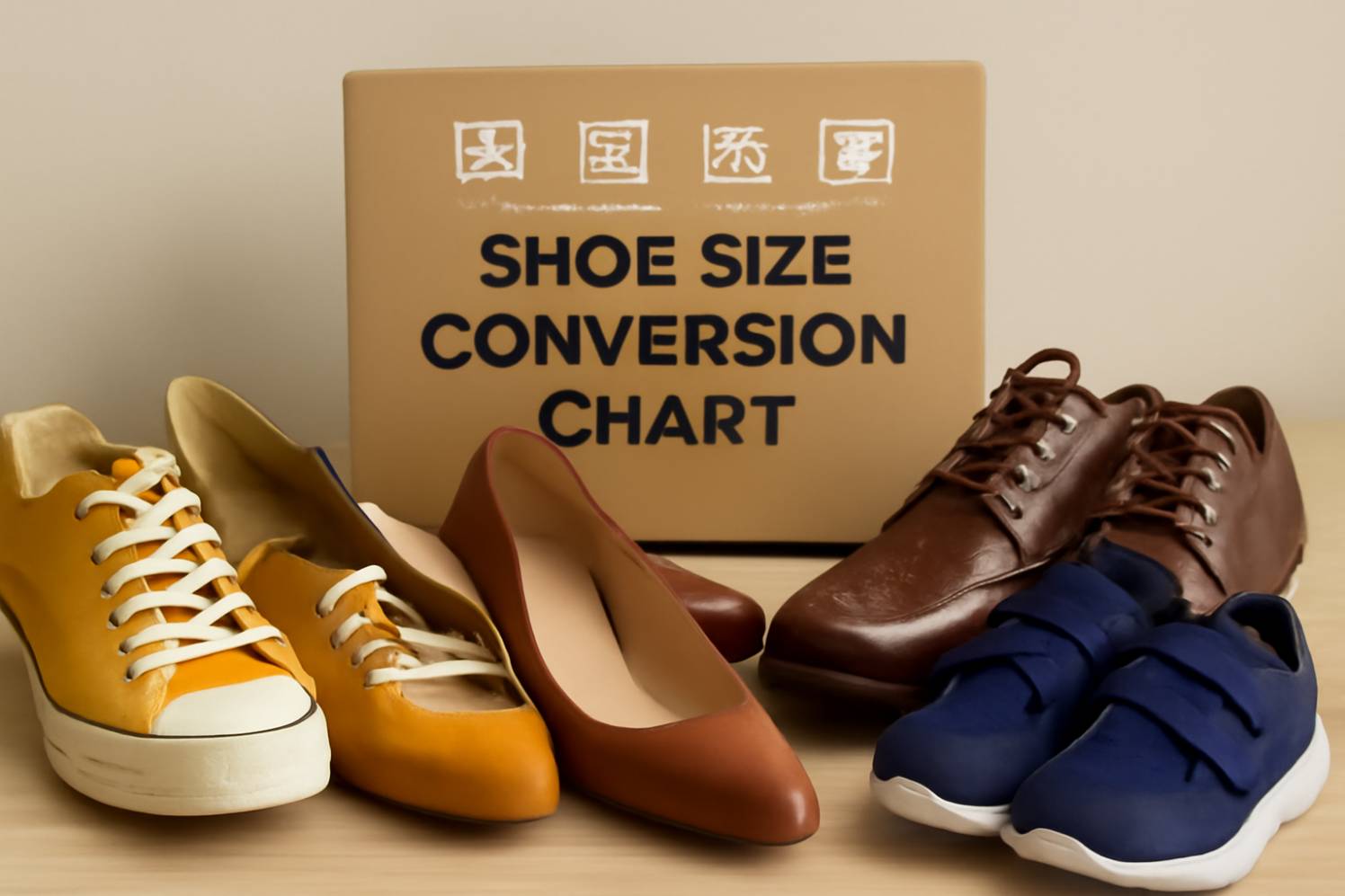
When shopping for shoes online or internationally, you might find yourself staring at a sizing chart, wondering how to convert between different countries’ sizing systems. Whether you’re eyeing a stylish pair of sneakers from Europe or classic boots from the UK, understanding how shoe sizes convert from one country to another can save you time, money, and frustration. A Shoe Size Conversion Chart is your best friend in these situations, helping you make accurate size conversions between the US, UK, EU, Japan, and beyond.
This guide covers everything you need to know about converting shoe sizes from various countries and regions, ensuring you always find the perfect fit, no matter where you’re shopping. From understanding foot measurements to navigating the complexities of men’s, women’s, and kids’ shoe sizes, we’ll break down all the information in a way that’s simple, understandable, and easy to apply.
By the end of this guide, you’ll feel confident in your ability to choose the right shoe size from any country. Whether you’re looking for US to EU shoe size conversions, figuring out men’s shoe size to women’s, or navigating international sizing differences, we’ve got you covered!
Understanding Shoe Sizing Systems

Before diving into conversions, it’s essential to understand how shoe sizes are measured in different countries and regions. Shoe sizing is not universal — each region has its unique system for determining the size of a shoe. The Shoe Size Conversion Chart simplifies this by helping you navigate between different systems. Here’s an overview of the most common methods used to measure shoes:
- US Shoe Size: The US system measures shoe size based on foot length in inches or barleycorns (a traditional English measurement). Men’s and women’s sizes are separate.
- UK Shoe Size: Similar to the US, but UK sizes are slightly smaller, and they use a system based on barleycorns (1 barleycorn = 1/3 inch).
- European (EU) Shoe Size: The EU system measures shoe size in Paris points, where 1 point equals 2/3 cm. This sizing system is used across much of Europe and is widely recognized internationally.
- Japanese (JP) Shoe Size: Japan uses a direct foot length measurement in centimeters, making it a straightforward system to understand.
- Mondopoint: This system uses foot length in millimeters and is typically used for sports shoes or boots.
Each of these systems can differ by as much as a full size, so it’s crucial to have a Shoe Size Conversion Table handy to ensure you’re buying the correct size.
Shoe Size Conversion Table: Men’s, Women’s, and Kids’ Shoe Sizes
Now that you understand the different sizing systems, let’s look at the Shoe Sizing Comparison. Below is a comprehensive chart that converts men’s, women’s, and kids’ shoe sizes across the most popular sizing systems. This will help you quickly find the right size, whether you’re shopping in the US, UK, EU, Japan, or elsewhere.
Men’s Shoe Size Conversion Table
| US Size | UK Size | EU Size | JP Size | China Size | Australia Size |
| 6 | 5.5 | 39 | 24.5 | 39 | 5.5 |
| 7 | 6.5 | 40 | 25 | 40 | 6 |
| 8 | 7.5 | 41 | 26 | 41 | 7 |
| 9 | 8.5 | 42 | 27 | 42 | 8 |
| 10 | 9.5 | 43 | 28 | 43 | 9 |
| 11 | 10.5 | 44 | 29 | 44 | 10 |
| 12 | 11.5 | 45 | 30 | 45 | 11 |
Women’s Shoe Size Conversion Table
| US Size | UK Size | EU Size | JP Size | China Size | Australia Size |
| 5 | 3.5 | 36 | 22.5 | 36 | 5 |
| 6 | 4.5 | 37 | 23 | 37 | 6 |
| 7 | 5.5 | 38 | 24 | 38 | 7 |
| 8 | 6.5 | 39 | 25 | 39 | 8 |
| 9 | 7.5 | 40 | 26 | 40 | 9 |
| 10 | 8.5 | 41 | 27 | 41 | 10 |
| 11 | 9.5 | 42 | 28 | 42 | 11 |
Kids’ Shoe Size Conversion Table
| US Size | UK Size | EU Size | JP Size | China Size | Australia Size |
| 10 | 9 | 27 | 16.5 | 27 | 9 |
| 11 | 10 | 28 | 17.5 | 28 | 10 |
| 12 | 11 | 29 | 18.5 | 29 | 11 |
| 13 | 12 | 30 | 19.5 | 30 | 12 |
| 1 | 13 | 31 | 20.5 | 31 | 13 |
| 2 | 1 | 32 | 21.5 | 32 | 1 |
How to Measure Your Foot for Accurate Shoe Sizing

While a Shoe Size Conversion Table can provide a general guide, it’s always a good idea to measure your foot to ensure a perfect fit. Here’s a simple step-by-step guide to measuring your foot:
Step 1: Prepare your materials
You’ll need a piece of paper, a pencil, a ruler or measuring tape, and a chair to sit in.
Step 2: Trace your foot
Place your foot on the paper and trace the outline. Make sure you are standing or sitting comfortably with your weight evenly distributed.
Step 3: Measure the length
Measure the distance from the heel to the tip of your longest toe in centimeters or inches. This will be your foot length.
Step 4: Measure the width
Measure the widest part of your foot to determine your foot width (narrow, medium, wide).
Step 5: Use the size chart
Compare your foot measurements with the Shoe Size Conversion Table to determine your shoe size in different systems.
Common Shoe Size Conversion Mistakes to Avoid
Even with a Shoe Size Conversion Table, there are still some common mistakes people make when trying to convert shoe sizes. Avoiding these errors will help you find shoes that fit comfortably and look great.
Not Considering Foot Width and Sizing Variations
One of the biggest mistakes when using a Shoe Sizing Guide is neglecting foot width. While many charts focus on foot length, shoe fit is not only determined by length but also by width. For example, you might be a US size 8, but if you have wide feet, a regular width shoe might not fit comfortably. Foot width is an essential factor for a good shoe fit, especially in women’s and men’s shoes.
Not Double-Checking Sizing Across Brands
Another common mistake is assuming that all shoes fit the same way. Shoe sizes can vary slightly depending on the shoe brands, even if they’re from the same country or region. Shoe Size Conversion Tables are helpful, but brand sizing can differ based on manufacturing practices. Some brands run large, while others may have smaller fits, so always check the size guide for each brand before making a purchase.
Misunderstanding Gender-Based Sizing
When shopping for men’s shoes to women’s, many people mistakenly assume that all shoe sizes convert the same way across genders. The truth is, men’s shoe size to women’s conversions aren’t always straightforward. For example, a men’s 8 is generally equivalent to a women’s 9.5 in US sizing. Understanding these conversions is crucial for ensuring you buy the right size, particularly when shopping online or internationally.
Country-Specific Shoe Size Conversion Breakdown
Different countries use various shoe sizing systems, which can lead to confusion when shopping for shoes globally. Let’s break down the main shoe size conversion systems used in different countries and how they compare to each other.
US Shoe Size System
The US shoe size system is the most widely recognized in North America. It’s based on foot length, measured in inches or barleycorns, and has separate sizing for men, women, and children. The US shoe size chart is also easy to convert to other systems once you understand the basics. Men’s sizes in the US tend to be larger than women’s, so make sure to check gender-specific conversions carefully.
UK and EU Shoe Size Conversions
One of the most common conversions people look for is EU shoe size to US for both men and women. European shoe sizes are typically 1-2 sizes larger than their US counterparts. European shoe size to US conversion can be tricky because the systems differ not only by length but also by how they measure foot width. Additionally, UK shoe size to US is often one size smaller. It’s essential to double-check these conversions, especially when buying shoes internationally, to ensure a comfortable fit.
Japanese Shoe Size System
Japan uses a unique shoe size system that directly measures foot length in centimeters, making it relatively straightforward. For example, a Japan size 25 corresponds to a foot length of 25 cm. This makes Japanese shoe size conversion easier for those who prefer using centimeters rather than inches or barleycorns.
China, Australia, and New Zealand Sizes
- China: China’s sizing system is similar to Japan’s, using foot length in centimeters. However, the conversions may differ slightly from Japan’s system. China shoe size to US conversion can vary depending on the manufacturer.
- Australia/New Zealand: These countries use a sizing system close to the UK’s but with some variations. Australia shoe size to US is typically equivalent to the UK size, so knowing the UK shoe size is helpful for accurate conversion.
Mondopoint System
The Mondopoint system is a metric-based sizing system used primarily for boots and sports shoes. It measures the foot in millimeters, making it precise. Though less common for casual shoes, Mondopoint is widely used in ski boots and military footwear.
Korean and Mexican Shoe Sizing
- Korea: Korean shoe sizes are similar to US shoe sizes, but there are some slight variations. Korean shoe size to US conversion is necessary for accurate international shopping.
- Mexico: Mexico uses a sizing system similar to US sizing, but it differs slightly in some cases. Always verify Mexico shoe size to US before making a purchase.
Final Tips for Buying Shoes Internationally
When shopping for shoes from international brands or online stores, always double-check your foot measurements, review the Shoe Size Conversion Table, and keep in mind that sizing can vary between brands. If you’re unsure, try to find customer reviews on fit or reach out to the brand for clarification on their size charts.
Also Read : Clothing Size Conversion Chart
FAQs About Shoe Size Conversion
Here are some frequently asked questions that can help clear up any confusion when dealing with shoe size conversions:
What is the best way to convert shoe sizes between countries?
The best way to convert shoe sizes is to use a Shoe Sizing Comparison chart, as it provides an easy reference for comparing sizes across different systems. Always ensure you measure your foot accurately and check the conversion table for the right match.
How do I convert my EU shoe size to US for women’s shoes?
To convert your EU shoe size to US for women’s shoes, subtract approximately 30 from your EU size. For example, if you wear an EU size 38, it would convert to a US size 7.5.
What is the most common shoe size chart used worldwide?
The most commonly used Shoe Size Conversion Table includes US, UK, EU, and JP sizes, as these are the most widely recognized systems worldwide. Many online stores use these charts for easier international shopping.
Do shoe sizes for men and women convert the same way?
No, men’s shoe size to women’s conversions are not the same across all regions. Typically, US men’s shoe sizes are about 1.5 sizes larger than women’s. For example, a men’s 8 is equivalent to a women’s 9.5 in US sizing.
Why does shoe sizing vary by brand even within the same country?
Shoe sizing can vary between brands because each brand has its own sizing standards. While the Shoe Size Conversion Chart can provide general guidance, different brands might have slight variations in how they manufacture their shoes.
What is the difference between European shoe size to US and UK shoe size to US?
The primary difference is that EU shoe size to US is typically 1-2 sizes larger than UK shoe size to US. For instance, a UK size 6 is about the same as a US size 8, whereas an EU size 39 is equivalent to a US size 8.
Recap of Shoe Size Conversion Key Points
We’ve covered the basics of Shoe Size Conversion, including the most common systems (US, UK, EU, Japan, China, and more), and provided detailed Shoe Size Charts for men, women, and kids. We also discussed common mistakes to avoid, such as not considering foot width and misunderstanding men’s shoe size to women’s conversions.



